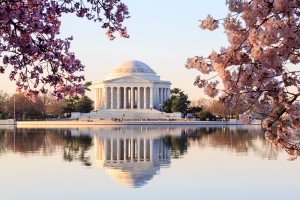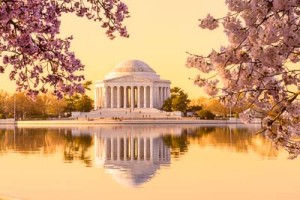Stock Photo experiments with Singh-Ray Gold-n-Blue Filter
We are always looking for something to move our images out of the ordinary to really capture the interest of the buyer (and hopefully the general public) to our stock photo images. Building up expertise in exposure, composition and processing in Lightroom (or Photoshop) helps tremendously, but what tools can give our photographs the edge? I’ve been experimenting with the Singh-Ray Gold-n-Blue polarizing filter which can make some spectacular changes to the scene in front of you – the sort of changes that would be almost impossible to reproduce in Photoshop alone. In this post, I’ll review some examples of the changes this filter can make to your shots. I was lucky to start with a pretty neat scene – dawn light illuminating the Jefferson Memorial in Washington DC with the famous Cherry Blossoms framing the scene. In earlier shots I used a flash to illuminate the cherry blossoms (which were in shadow at dawn), but by the time I found this shot the sun was just high enough to light the blossoms in front of me. Because of the depth of field issues, I took three shots in succession, focused on the monument, the left flowers and then the right blossoms, and stacked them in Helicon Focus (this cleverly blends the in-focus elements of the various frames). Here is the natural shot – processed in Lightroom with the basic exposure and clarity adjustments I make to most images:
Then I added my Gold-N-Blue filter – the camera was on a tripod as the exposure was around 1/5th second – and so I could rotate the filter without making much change to the composition. The first one I tried was aiming at a warmer natural look and so aimed for slightly bluer water in this one. Somewhat strangely, you see a normal (albeit modified) image in the camera viewfinder but the Raw files all have a magenta hue. You need to find an appropriate white balance when you are processing – which can often be far away from the normal daylight settings. Here is the first image with the filter:
Then I went for the bright gold view on the reflective surfaces. This is a polarizing filter and so it mainly alters the areas that a polarizer would darken – reflections in water, the sky (at 90 degrees to the sun) – and the other elements – the monument and the flowers are not changed as much. Hence you can make a major change to those polarized areas of the image:
Finally, I wanted something a little more ethereal, and so I rotated to give the water and sky a more blue tint, and then processed it in Lightroom to warm up the monument itself to give a dreamy peaceful feeling – perfect for a calendar, I think!
I think this one is my personal favorite – I can imagine this printed large on my wall at home. Perhaps I’ll experiment more on blending (in Photoshop) the different versions to get the gold in the lower sky to simulate the sunrise light with upper areas appearing blue.
One final point – the downside, if you like. The filter is not cheap – $240 for normal filter sizes. It has been mentioned to me that you can achieve similar results using software from Nik, for example and get their entire suite for less than $200. Fair point – I’m not convinced that you can shift individual colors in software as much as you can with this filter. I often find that you get unwanted aberrations around the edge of different colored objects (like the blossoms in this example), but it is always something to think about. I enjoy having my creative juices flowing when I am taking the shots and perhaps that is why the filter works for me – but it is your choice!











1 Response
[…] in the car and just take my new 16-35mm F4L lens (the one with Image stability) and also try the Singh-Ray Gold’n'Blue filter. I often find that I put a lens on the camera and that is fine for an hour or two – your eye […]